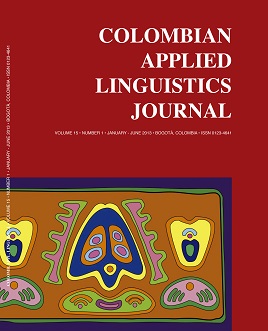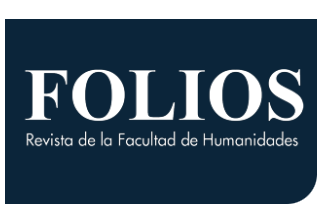DOI:
https://doi.org/10.14483/udistrital.jour.calj.2013.1.a06Published:
2013-01-01Issue:
Vol 15, No 1 (2013) January-JuneSection:
Research ArticlesThe role of situational context and linguistic context when testing EFL vocabulary knowledgde in a language teacher education program: a preliminary approach
El papel del contexto situacional y lingüístico al evaluar el conocimiento de vocabulario en ingles en un programa de formación del profesorado de idiomas; una primera aproximación
Keywords:
pruebas de vocabulario, amplitud de conocimiento del vocabulario, la profundidad del conocimiento de vocabulario, vocabulario receptivo, vocabulario productivo, contexto situacional, contexto lingüístico (es).Keywords:
vocabulary testing, breadth of vocabulary knowledge, depth of vocabulary knowledge, receptive vocabulary, productive vocabulary, situational context, linguistic context (en).Abstract (en)
This research aims to provide a preliminary approach on to what extent linguistic and situational contexts are conducive to successful vocabulary recognition in discrete-item testing in the context of a language teacher education program in Bogotá. This study resorted to the use of four different types of vocabulary tests administered during a one-semester period to two different classes. The data collected revealed that students had more success in a test of productive vocabulary (L2 to L1 translation) than in other types of tests, namely, productive vocabulary (L2 to L1 translation/multiple choice), L2 to L1 translation provided with linguistic context and cued situational context. The findings of this research suggest that the participating pre-service teachers had not reached the basic vocabulary knowledge of the English Language at the time of this study. It was also found that vocabulary items devoid of contextual cues are more accurately identified than those embedded within a linguistic context and a cued situational context.
Abstract (es)
El propósito principal de esta investigación, es comprender – en qué medida el contexto lingüístico y situacional propician el reconocimiento exitoso _ en una prueba de vocabulario aislada en un programa de formación de docentes en idiomas en Bogotá. Para llevar a cabo este fin, se aplicaron en un semestre cuatro tipos de pruebas a dos grupos diferentes. La información recolectada demostró que los estudiante obtuvieron mejores resultados en una prueba productiva de vocabulario (traducción de L1 a L2), pero en las pruebas de traducción de L1 a L2 / selección múltiple, traducción de L2 a L1 con contexto lingüístico y situacional y de reconocimiento de L2 con claves discursivas y visuales, los resultados fueron más bajos. Los hallazgos en esta investigación sugieren que al momento de ser efectuada, los docentes en formación no habían alcanzado el reconocimiento de vocabulario básico en la lengua inglesa. También se encontró que las pruebas desprovistas de contexto fueron reconocidas más fácilmente que aquellas con uno lingüístico y situacional.
References
Andersen, R. (1983). The Architecture of Cognition.
Cambridge: Harvard University
Angouri, J. (2010). Quantitative, Qualitative or both?
Combining research methods in Linguistics in Litosselliti, L (Ed.), Research Methods in Linguistics (pp. 49 – 67) London: Continuum Books.
Bachman, L. (1990). Fundamental Consideration in
Language Testing. Hong KONG: Oxford University
Press.
Bauerlein, M. (2009) The Dumbest Generation How The Digital Age Stupefies Young Americans and Jeopardizes our Future. New York: The Penguin Group.
Brown, H.D. (2004). Language Assessment Principles
and Classroom Practices. Pearson, White Plains,
New York.
Block, D. (2009). Second Language Identities. London:
Continuum books.
Chikamatzu, N. (2006). Developmental Word Recognition: A Study of L1 English Readers of L2 Japanese. The Modern Language Journal, 90(I), 67-85
Kramsch, C.(1993). Context and Culture in Language
Teaching. Oxford: Oxford University Press.
Coady, J. (1997).L2 Vocabulary acquisition: A synthesis of the research. In J. Coady & T. Huckin (Eds.), Second language vocabulary (pp. 273-390). Cambridge: Cambridge University Press.
Castaño, E. & Raidosa, B.E.(2001). Mercados populares mayoristas de alimentos en la Zona Andina Central Colombiana. Manizales, Caldas: Centro Editorial Universidad de Caldas.
Council of Europe (2001). Common European Framework of References for Languages
Learning Teaching, Assessment (2001). New
York:Cambridge University Press.
Dane (2009, March 17). TV, ocio y vida social, los planes de los colombianos en el tiempo libre. El Tiempo. Retrieved from: http://www.eltiempo.com/archivo/
documento/CMS-4884520
Ellis, R. (2008). The study of Second Language Acquisition. New York: Oxford University Press.
Fromkin, V, Rodman, R and Hyams, N. (2011). An introduction to language. Boston, MA : Wadsworth
Publishing.
Gyllstadt, H. (in press). Testing L2 Vocabulary: Current
Test Formats in English as a L2 Used at Swedish
Universities. Retrieved from: http://lup.lub.lu.se/
luur/download?func=downloadFile&recordOId=52
&fileOId=624536
Hall, R. (1976). Beyond Culture. New York: Anchor
Books.
Henriksen, B (1995). What does it mean to know a word?
Understanding words and mastering words. Sprogforum,
, 12 - 18. Retrieved from: http://inet.dpb.
dpu.dk/infodok/sprogforum/Espr3/Henriksen.html
Hwang, K. and Nation, I.S.P. (1995) Where would general service vocabulary stop and special purposes
vocabulary begin? System, 23 (1), 35-41.
Kramsch, C. (1993). Context and Culture in Language
Teaching. Oxford: Oxford University Press.
McNeil, A. & Vera, E. (2004). Dos Propuestas Metodológicas Hipermediales para Mejorar La Comprensión Auditiva en Inglés. Folios, 19, (2), 103-110.
Meara, P. (1989). Matrix Models of vocabulary acquisition. In P. Nation & Carter R. (Eds.), Vocabulary
Acquisition Aila Review-Revue de l’Aila (pp.66 -74).
AILA Review 6: Association Internationale Linguistique
Appliquée.
Melo, J (2011, May 3). Hacia un país de lectores: grandes avances, grandes desafíos Una vieja aspiración: que todos lean y escriban. Revista Numero. Retrieved from: http://www. revistanumero.com/index.php?option=com_ content&view=article&id=794
Meara, P. (1990). A Note on Passive Vocabulary. Lognostics. Tools for Vocabulary Research. Second Language Research, 6 (2), 150-154. Retrieved from: http:// www.lognostics.co.uk/vlibrary/meara1990.pdf
Mitchell, R. & Myles, F.(2004). Second Language Learning Theories. London: Hodder
Nation, I.S.P.(2001). Learning Vocabulary in Another
Language. Cambridge: Cambridge University Press.
Nation, P, & Wang M.K.(2009). Graded readers and
vocabulary. Reading in a foreign language, 12, (2),
- 380
Palfrey, J. & Gasser, U. (2008). Born Digital. New York :
Basic Books.
Pan, B.A., Rose M.L., Singer J.D. & Snow C.E.(2005).
Maternal Correlates of Growth in Toddler Vocabulary
Production in Low-Income Families. Child Development. 76 (4), 763-782.
Qian,D. (2005). Demystifying Lexical Inferencing: The role of aspects of vocabulary knowledge. TESL Canada Journal. 22, (2), 34-54.
Rasinger, S. (2008). Quantitative Research in Linguistics. Exeter, United Kingdom: Continuum
Read, J (1993).The development of a new measure of
L2 vocabulary knowledge. Language Testing,10
(3), 355-371. Retrieved from http: //ltj.sagepub.com
Read, J. (2000). Assessing Vocabulary. Cambridge,
England: Cambridge University Press.
Read, J.& Nation, I.S.P. (1986). Some issues in the testing of vocabulary knowledge. Paper presented at
the LT+25 Symposium, 11-13 May 1986, Quiryat
Anavim, Israel.
Sanaovi, R. (1995). Adult Learners’ Approaches to Learning Vocabulary in Second Languages. The Modern Language Journal. 79, (1), 15-28.
Schmitt, N. (2005). Current Trends in Vocabulary Learning and Teaching. In: Handbook of English Language Teaching Dordrecht: Kluwer Academic Publishers.
Schmitt, N.(2010). Researching Vocabulary: A VocabularyResearch Manual: A Vocabulary Research Manual Basingstoke.U.K.: Palgrave McMillan.
Stahl, K. A. D., & Bravo, M. (2010). Contemporary classroomvocabulary assessment for content areas.
Reading Teacher, 63, 566-578.
Thornbury, S. (2007). How to Teach Vocabulary. Harlow: Longman.
Waring, R. (1997). A comparison of the receptive and
productive vocabulary sizes of some second language
learners. Immaculata 1: 53-68
Weir, C.(2005). Language Testing and Validation: An
Evidence-Based Approach. Basingstoke.U.K.: Palgrave
McMillan.
Yule, G. (2010). The study of language. United Kingdom: Cambridge University Press.
How to Cite
APA
ACM
ACS
ABNT
Chicago
Harvard
IEEE
MLA
Turabian
Vancouver
Download Citation
Metrics
License
This work is licensed under a Creative Commons Attribution-NonCommercial-NoDerivatives 4.0 International License.
Attribution — You must give appropriate credit, provide a link to the license, and indicate if changes were made. You may do so in any reasonable manner, but not in any way that suggests the licensor endorses you or your use.
NonCommercial — You may not use the material for commercial purposes.
NoDerivatives — If you remix, transform, or build upon the material, you may not distribute the modified material.
The journal allow the author(s) to hold the copyright without restrictions. Also, The Colombian Apllied Linguistics Journal will allow the author(s) to retain publishing rights without restrictions.















.JPG)










